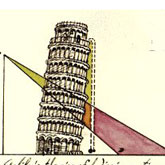The Equivalence Principle
 Four hundred years ago--or so the story goes--Galileo Galilei started dropping things off the Leaning Tower of Pisa: Cannon balls, musket balls, gold, silver and wood. He might have expected the heavier objects to fall faster. Not so. They all hit the ground at the same time, and so he made a big discovery: gravity accelerates all objects at the same rate, regardless of their mass or composition. Nowadays this is called 'Universality of Free Fall' or the 'Equivalence Principle,' and it is a cornerstone of modern physics. In particular, Einstein crafted his theory of gravity, i.e., the general theory of relativity, assuming the Equivalence Principle is true. But what if it's wrong? A group of NASA-supported researchers are going to test the Equivalence Principle by shooting laser beams at the Moon.
Four hundred years ago--or so the story goes--Galileo Galilei started dropping things off the Leaning Tower of Pisa: Cannon balls, musket balls, gold, silver and wood. He might have expected the heavier objects to fall faster. Not so. They all hit the ground at the same time, and so he made a big discovery: gravity accelerates all objects at the same rate, regardless of their mass or composition. Nowadays this is called 'Universality of Free Fall' or the 'Equivalence Principle,' and it is a cornerstone of modern physics. In particular, Einstein crafted his theory of gravity, i.e., the general theory of relativity, assuming the Equivalence Principle is true. But what if it's wrong? A group of NASA-supported researchers are going to test the Equivalence Principle by shooting laser beams at the Moon.
Their experiment is possible because, more than 30 years ago, Apollo astronauts put mirrors on the Moon--small arrays of retroreflectors that can intercept laser beams from Earth and bounce them straight back. Using lasers and mirrors, researchers can 'ping' the Moon and precisely monitor its motion around Earth. It's a modern version of the Leaning Tower of Pisa experiment. Instead of dropping balls to the ground, the researchers will watch the Earth and Moon drop toward the Sun. Like musket balls and cannon balls dropped from the Tower, the Earth and Moon are made of a different mix of elements, and they have different masses. Are they accelerated toward the Sun at the same rate? If yes, the Equivalence Principle holds. If not, let the revolution begin. Scientists have been pinging the Moon since the Apollo days. So far, Einstein's theory of gravity--and the Equivalence Principle--has held up to a precision of a few parts in 1013.
But that's not good enough to test all the theories vying to overthrow Einstein. Current lunar laser ranging can measure the distance to the Moon--roughly 385,000 km--with an error of about 1.7 cm. Beginning this fall, a new facility funded by NASA and the National Science Foundation will boost this accuracy 10-fold to within only 1 to 2 mm. This jump in accuracy will mean that scientists can detect deviations from Einstein's theory 10 times smaller than currently possible, which may be sensitive enough to find the first evidence of flaws. To achieve that accuracy, the facility, called the Apache Point Observatory Lunar Laser-ranging Operation (APOLLO), must time the laser pulses' roundtrip flight to the Moon within a few picoseconds, or just a trillionth of a second (10-12). From Pisa, Italy, to the Moon, to White Sands, New Mexico: this is a far-flung experiment spanning hundreds of years and hundreds of thousands of miles. Soon, perhaps, we'll have the answers.
About the Author
NASA Marshall Space Flight Center
 The George C. Marshall Space Flight Center, located in Huntsville, Alabama, is the U.S. government's civilian rocketry and spacecraft propulsion research center. As the largest NASA center, MSFC's first mission was developing the Saturn launch vehicles for the Apollo program.
The George C. Marshall Space Flight Center, located in Huntsville, Alabama, is the U.S. government's civilian rocketry and spacecraft propulsion research center. As the largest NASA center, MSFC's first mission was developing the Saturn launch vehicles for the Apollo program.


